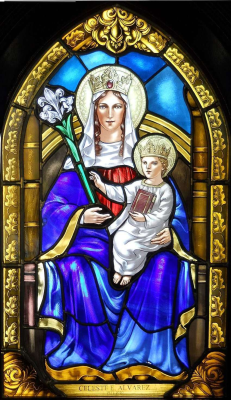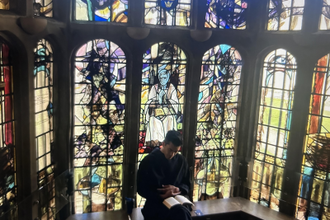Gospel in Art: Feast of Our Lady of Walsingham

Our Lady of Walsingham, All Saints Episcopal Church, Waveland, Florida, Stained glass window, 2010 © All Saints Waveband, Wikimedia
Source: Christian Art
Gospel of 24 September 2024
Luke 1:26-38
The angel Gabriel was sent by God to a town in Galilee called Nazareth, to a virgin betrothed to a man named Joseph, of the House of David; and the virgin's name was Mary. He went in and said to her, 'Rejoice, so highly favoured! The Lord is with you.' She was deeply disturbed by these words and asked herself what this greeting could mean, but the angel said to her, 'Mary, do not be afraid; you have won God's favour. Listen! You are to conceive and bear a son, and you must name him Jesus. He will be great and will be called Son of the Most High. The Lord God will give him the throne of his ancestor David; he will rule over the House of Jacob for ever and his reign will have no end.' Mary said to the angel, 'But how can this come about, since I am a virgin?' 'The Holy Spirit will come upon you' the angel answered 'and the power of the Most High will cover you with its shadow. And so the child will be holy and will be called Son of God. Know this too: your kinswoman Elizabeth has, in her old age, herself conceived a son, and she whom people called barren is now in her sixth month, for nothing is impossible to God.' 'I am the handmaid of the Lord,' said Mary 'let what you have said be done to me.' And the angel left her.
Reflection on the stained glass window
The Feast of Our Lady of Walsingham celebrates one of England's most revered Marian shrines, located in Walsingham, Norfolk. Its origins date back to 1061, when, according to tradition, Richeldis de Faverches, the lady of the manor, had a series of three visions in which the Virgin Mary appeared to her. In these visions Richeldis was shown the house of the Annunciation in Nazareth and was told to build a replica of the house in Walsingham as a place of pilgrimage where people could honour the Virgin Mary. Mary is said to have promised, "Whoever seeks my help there will not go away empty-handed."
Walsingham became a major pilgrimage site in medieval times, attracting pilgrims from across Europe. It was often referred to as "England's Nazareth," reflecting its importance as a spiritual centre. However, the shrine, along with many others, was destroyed during the Reformation under Henry VIII, as part of the dissolution of the monasteries. Despite the destruction of the original shrine, devotion to Our Lady of Walsingham experienced a revival in the 19th and early 20th centuries. Both Anglican and Catholic communities re-established the pilgrimage tradition, and today, Walsingham once again draws pilgrims from around the world. The site now includes both the Anglican Shrine of Our Lady of Walsingham and the Catholic National Shrine, re-established in 1897.
Our stained glass window was installed in 2010 at the All Saints Episcopal Church, Waveland (Jensen Beach, Florida). Our Lady of Walsingham is traditionally depicted as a seated figure of the Virgin Mary, symbolising Mary as the Seat of Wisdom (or Sedes Sapientiae in Latin). She is holding the Christ child on her lap, supporting and presenting Christ to the world. By sitting, Mary reflects her role as a stable, nurturing presence, and as a queen, pointing to her revered position in heaven. The lily in Mary's hand is a symbol of her purity and virginity, specifically tied to the Annunciation, when the angel Gabriel told Mary she would conceive Christ by the Holy Spirit. Mary and Christ wear crowns to symbolise their royal dignity and authority. Mary is crowned as the Queen of Heaven, reflecting her honoured role as the Mother of God and her assumption into heaven. Christ wears a crown to signify his role as the King of Kings, highlighting his divine authority over all creation.
LINKS
Gospel in Art: https://christian.art/
Today's Reflection: https://christian.art/daily-gospel-reading/luke-1-26-38-2024-2/


















